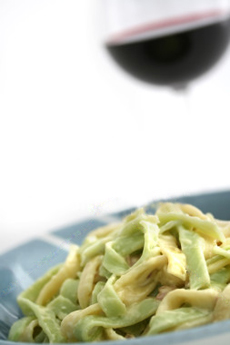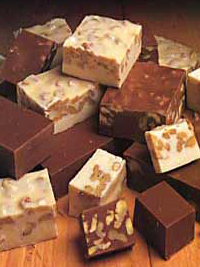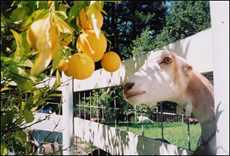
June 2005
|
 |
The Gourmet Goat
Parlez-Vous Chèvre?
If you had never had a piece of cheese and were to look at the three major cheese-producing animals before making a decision, chances are you’d pick the goat over the cow or sheep. Intelligent, agile, sprightly and more fragrant and spotless than her fellow cheese-givers, the goat looks like she’ll offer you something clean and elegant.
| *Chevre, the French word for goat, is also used for goat cheeses. |
And so she does. While it can be hard to distinguish if you are eating a cow cheese or a sheep cheese, goat cheeses generally introduce themselves with a distinguishing lemony tang that causes many people to define themselves as “goat cheese lovers.” By contrast, we can’t remember hearing anyone call out the other two animals when referring to themselves as cheese lovers.
Many people think of goat cheese in terms of fresh chèvre in disks and logs, barrel-shaped crottins and pyramids, often cinder-coated. But goat’s milk is used to make cheese in virtually every category. If you haven’t fully experienced the range of goat cheeses—from semisoft cheeses to aged goat parmesans to goat blue cheeses—head over to your cheese store and pull together a tasting.
While you’re there, bring home a quart of goat milk and some goat’s milk yogurt. If you love the rich, clean taste of goat cheese, see what the source material (milk) tastes like. The yogurt tastes very much like the freshest goat cheese, and is available plain and flavored.
Thanks to the American Dairy Goat Association for much of the information in this article. See specific articles on cheese and yogurt in their respective sections.
Good For You
Aside from providing food-lovers with great cheese selections, goat’s milk products are good for you. Long considered an alternative for those with cow’s milk sensitivities, people who are lactose-intolerant (or otherwise have difficulty digesting milk products) can often enjoy goat cheese with impunity.
- Goat’s milk is more digestible due to its smaller, naturally homogenized fat globules.
- Goat’s milk also has a higher percentage of short- and medium-chain fatty acids than cow’s milk and is lower in cholesterol. It’s higher in calcium, phosphorus, and vitamins A and B. (Goat’s milk has virtually the same calories as cow’s milk)
Caring For Goat Milk Cheeses
Goat milk cheeses are more delicate in texture than cow and sheep milk cheeses, and require gentle handling.
- Keep them very cold, well-covered and tightly wrapped in butcher or wax paper. You also can keep them in a Tupperware-type plastic container. There is a debate about plastic wrap: Some people advise against it because it prevents the cheese from breathing and can make it sweat if not properly refrigerated. If you are buying cheese for short-term consumption, plastic should not be a detriment; and you should never buy more cheese than you plan to eat during the week.
- Remove all cheeses from their packaging and let them come to room temperature before serving.
Using Goat’s Milk Products
Goat Milk
- Use fresh goat milk in place of light cream in soups and sauces.
- Goat milk improves the texture of breads and cakes.
- Goat milk makes a rich, melt-in-your-mouth fudge (recipe below).
Goat’s Milk Yogurt
- Use goat milk yogurt in place of sourer cream in dips, sauces and salad dressings. The texture is light and creamy, with fewer calories.
- Try it with your next smoothie: a delightful change of pace.
Cooking
- Use goat milk yogurt to add new flavor dimension to traditional yogurt dishes like raita and tzatziki (click here for recipes).
- Substitute goat cheese for cow cheeses in traditional cheese puff and gougère recipes, or any recipe requiring cheese (see the Fettuccini Casserole below).
- If you’re a cheesecake lover, do try making your next cheesecake with fresh goat cheese instead of cream cheese or ricotta (recipe below).
- Soft cheeses are delicate and become more liquid as they are beaten or heated, so don’t overprocess them.
- Aged, hard goat cheeses usually offer more flavor. You can generally use less of them in recipes that call for aged cheese.
Recipes
Sweet or savory, goat’s milk products are wonderful in cooking. Here are recipes for fettuccine, fudge and cheesecake. Look at the websites of goat cheese producers for more recipes.
Fettuccine Casserole
If you like Fettuccine Alfredo, try this goat milk version.
Ingredients
- 1 lb. fettuccine or egg noodles
- 4 tablespoons butter or 1/4 cup olive oil
- 6 cloves garlic, pressed
- 2 tablespoons chopped chives
- 2 tablespoons fresh parsley
- 1 cup goat milk
- 8 ounces soft fresh goat cheese, or 15 ounces goat milk ricotta
- 3/4 cup dry, aged goat cheese (Romano- or Parmesan-style), grated
- Optional: sautéed mushrooms and peas
|
 |
Directions
- Cook fettuccine al dente; drain and set aside.
- Melt butter or oil over low heat. Add garlic, chives, and parsley. Sauté two minutes.
- Heat goat milk in a saucepan over low heat and stir in soft goat cheese until it is dissolved. Do not boil.
- When hot, add the butter, chives and parsley mixture, the drained noodles, 1/2 cup of the grated cheese, and the optional mushrooms and peas. Toss well and place in an oiled casserole.
- Bake covered at 350°F for 45 minutes.
- Uncover, top with the remaining grated cheese, and bake another 15 minutes or until the top is golden. Serve immediately.
|
Chocolate Goat Milk Fudge
Ingredients
- 2 1-ounce squares unsweetened chocolate (or
substitute 1/3 cup cocoa and 3 tablespoons butter)
- 3/4 cup fresh goat milk
- 2 cups sugar
- 1 teaspoon light corn syrup
- 2 tablespoons butter
- 1 teaspoon vanilla
Directions
|

Photo courtesy of WoodstockCandy.com |
- Melt chocolate in milk. Add sugar and corn syrup.
- Cook slowly, stirring constantly until the sugar dissolves. Cook gently to the softball stage (260°), stirring frequently.
- Remove from heat; add butter and cool at room temperature until lukewarm (110°) without stirring.
- Add vanilla; beat vigorously until fudge becomes very thick and loses its gloss.
- Quickly spread in a buttered pan.
- When firm, cut into squares. Makes about two dozen pieces.
Cajeta (Mexican Caramel Candy)
Ingredients
- 3 quarts goat milk
- 2 tablespoons cornstarch
- 3 cups sugar
- ¼ teaspoon baking soda
Directions
- Dissolve baking soda and cornstarch into 1 cup milk. Stir well to dissolve any lumps.
- Add rest of milk and add sugar.
- Bring mixture to boil, stirring constantly while cooking. Cook until the mixture is thick and looks like caramel sauce.
- Pour into jars, cool, and refrigerate. This makes a great topping for ice cream and makes a delicious apple dip!
|
© Copyright 2005-2026 Lifestyle Direct, Inc. All rights reserved. All images are copyrighted to their respective owners.
|




